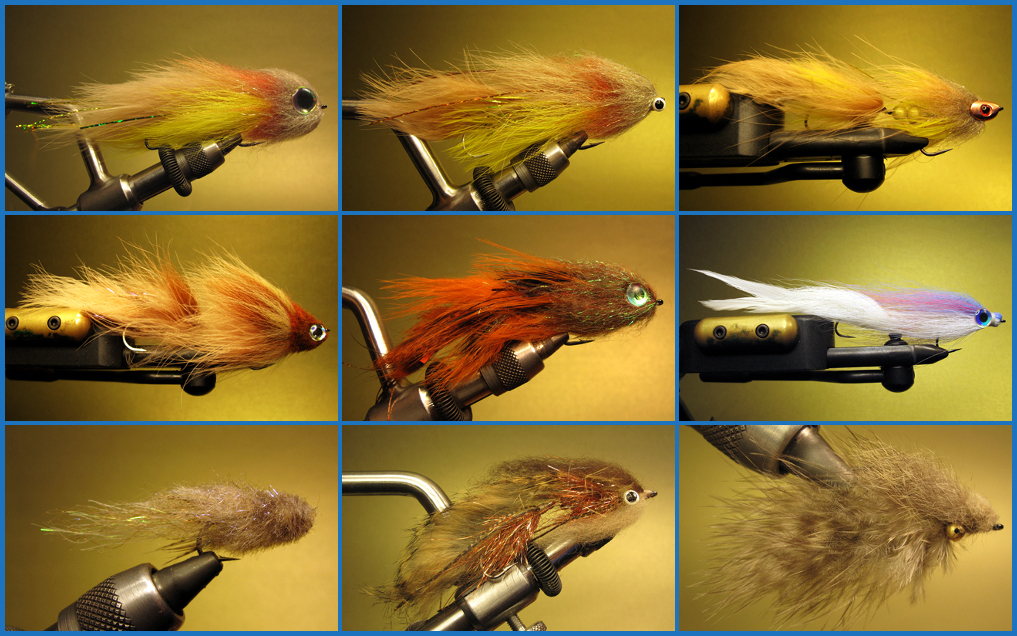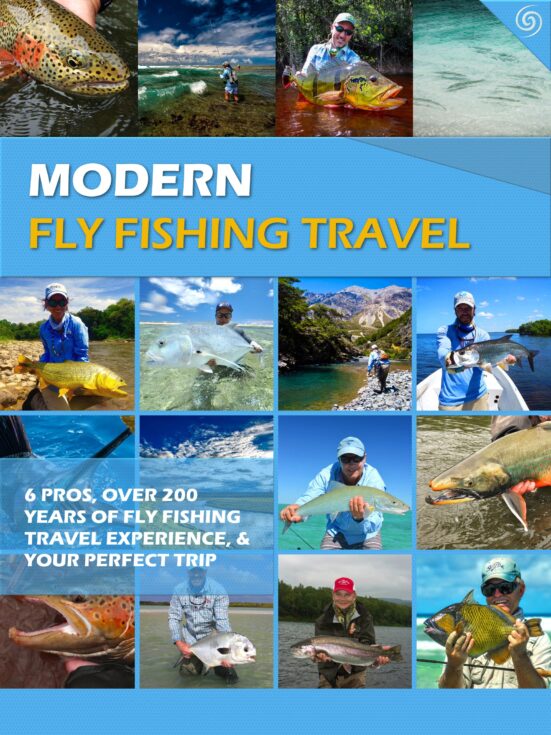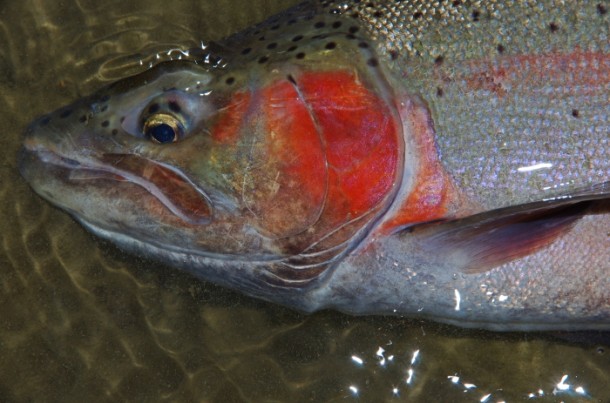Streamer flies have a tendency to get lost in a vast sea of bunny and deer hair. The common term for these flies is “meat”—“we threw meat today”. While this term makes a lot of sense, the differences in streamer patterns also often end up being lost when you throw your flies into a fly box (see the Feather Craft “Meat Locker”). Carnivores like meat, but any novice carnivore can tell you that not all meat is the same. So it goes with streamer flies. There is a whole lot more to choosing and designing streamers than the meaty exterior might suggest. In this article, streamer expert Mike Schmidt from Angler’s Choice Flies helps us all to not butcher our streamer fly selection and design, by going through some of the key features of streamers and streamer selection.
What is your basic approach to designing and constructing streamers?
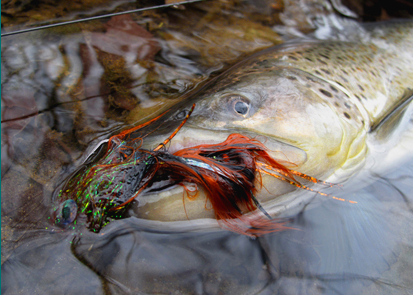
TROUT ULTIMATELY DETERMINE SUCCESS, BUT MAKE SURE YOUR DESIGN IS RIGHT FIRST.
“Most of the time when I want to design a streamer, it begins as a problem solving exercise. I think about a specific situation in the water and how I can present a fly in a particular manner to the fish in this specific situation. This can include getting the fly to a certain depth, to swim a certain way, or to mimic a certain prey item specifically. Once I have the problem in my head and then think I have a solution, I get it down on paper so that I don’t forget about it. I’ve got notebooks full of stick figure streamer flies that I’ve drawn out and given notations on how I think a particular fly’s going to act. I will literally write out the materials that are going to be best served, draw those patterns out, and then think them out in my head. Sometimes, I’ll be thinking about a situation and literally driving around in my car, and I’ll pull off and make a quick sketch. I’ve got a book that I keep on the passenger side of my car that I keep for that exact situation. Then, when I get to the vice and tie up the first version of it, I try to do it as close as I can to what the drawings were. Sometimes that works, and sometimes I realize, as I’m doing it, that what I thought I was going to do isn’t going to work. Then, you go to the water and see if it works. By ‘works’, I mean did I get the action that I wanted out of that fly. If it doesn’t catch a fish, that doesn’t mean that it doesn’t work. Catching fish on a streamer is, of course, the object, but maybe when you’re going to test that fly, you don’t have the exact conditions for which you designed the fly in the first place. The fly needs to do what you want. Then when the right conditions present themselves, you can fish it and see if the fish agree.”
How would you organize streamer flies with respect to features that determine the fly’s action?
“There are four major features that impact action: whether or not a streamer is weighted or unweighted and whether or not a streamer has a bulky head or is streamlined. Weighted streamer flies are typically going to give you more of a vertical jig or serpent swim. Unweighted flies are typically going to give you more of a side-to-side or a straight-on darting action. Bulky heads are going to kick the tail around quite a bit more and give the tail more movement, depending on the current and the action you impart to the fly. Another feature of a bulky head is when you pause the fly. On a stop, you will get more of a side-to-side hinging action like with Blane Chocklett’s T-Bone Musky Fly, which just turns into a “U” on the pause. Also, how much force you’re going to need to have in your stripping motion to get your fly’s tail to move in a certain way or how much water speed you’re dealing with will dictate which head style you use and which one will be more effective, since you do not have to strip as hard with a bulky head fly pattern to get the tail to move.”
How do materials on the tail portions of articulated patterns, or on streamers in general, affect the selection of streamer flies?
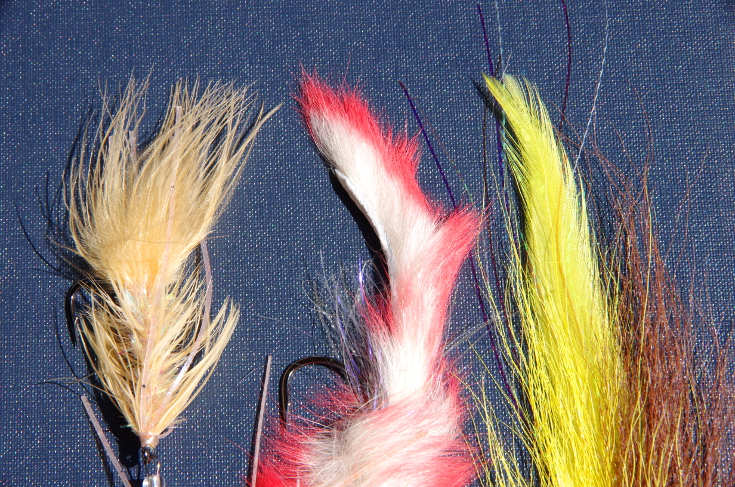
THE MATERIAL OF YOUR FLY IS OFTEN BETTER SUITED FOR SPECIFIC SITUATIONS.
“Most of the time, if a fly is built correctly, schlappen or hackle as a tail is not going to have as much movement in slow water as a material like bunny. Bunny has the most movement of any material ever created. It’s amazing in the water, and schlappen or hackle is not going to have that type of movement in the water on the pause. Schlappen will maintain form and function during a strip and will typically kick to one side at the end of a strip. Bunny collapses on the strip and will flutter and then come to life on the pause. So, these materials give you a different look in the water. Bunny will normally not kick, but you can design the fly to do this. Marabou is not going to kick the tail around at all but will have a ton of movement even at a slow stripping speed. The speed of the water you’re fishing or the speed of your retrieve is going to tell you what material will give you a better action. For example, when we are fishing the White River, the water can be moving pretty quickly, and you’re normally moving that fly pretty quickly on the strip. Typically, you will not see a lot of marabou on the back half of flies here because the marabou slims down to virtually nothing unless you’ve built a head that keeps the marabou from collapsing on the strip. Flies here are commonly built with bucktail and schlappen, which maintain profile, even on a faster strip. Once you know the type of water you are going to fish, you can possibly eliminate flies because they’re not going to perform in the water like you want them to, based off of current speed.”
What are some general guidelines for size and shape of streamer flies?
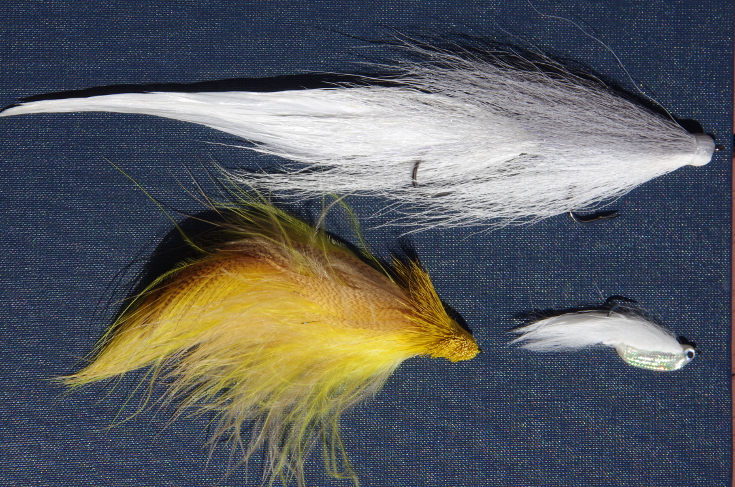
THE SIZE OF THE PREY CAN HELP NARROW DOWN FLY SIZE.
“Pay attention to what you’re fly is doing in the water and to your surroundings when it comes to the characteristics of your streamer flies. If you are out there fishing a six-inch fly, but you’re only seeing four-inch baitfish, then maybe you’re fishing too big, or vice versa. It is very similar to matching the hatch. You want to match the size of the forage in the body of water. Like when you’re dry fly fishing, there’s always the off chance that you will catch a fish on an imitation for a prey item that isn’t present. That doesn’t mean that you are not going to catch a fish on streamer flies if you’re fishing a streamer that doesn’t match the local forage. In general though, the closer you can get your fly to look and act like what fish are used to seeing, the more likely they are going to eat it out of a food response. On the other hand, you can always strip a large pattern fast and hard to try and get fish on an aggression take, but again you’re generally going to have the most success when you fish something that looks like what the fish are used to seeing in a given water. For example, I’ve fished weighted sculpins in deep pools on barren Wyoming streams. These streams have no sculpins, and the fish have never seen sculpins. However, if you throw on a three to four-inch copper and yellow-colored streamer and burn it through the water, they’re going to eat that. When it comes to streamer size in general, in most cases, a five-inch articulated streamer is a go-to fly that I would feel comfortable fishing with pretty much anytime.”
Mike shares more on streamers and particularly on color choices in this Orvis podcast.
If you had to choose three of your patterns and your life depended on it, what would they be—you could also take along two others from any tyer?
“I would take probably the Meal Ticket, Red Rocket, and six-inch Double Deceiver. If you opened it up to other stuff, Lynch’s Drunk and Disorderly is stupid successful for anything that I’ve fished for with it, as is Schulz’s Swinging or Deep D anywhere we have fished it.”
The moral of the story is that we are indeed throwing “meat”, but we should aspire to fill our Meat Lockers with the skill of a French chef rather than Attila the Hun. Streamer flies have as many subtleties, if not more, as any dry fly or nymph. To be consistently successful, you have to design and fish your streamers with a lot of thought—maybe a little hunger as well. Meat anyone?

MIKE SCHMIDT
is an expert on streamer tying and fishing and owner of Angler’s Choice Flies. He is a native of Michigan and is as in tune with the fly fishing community of the Midwest and East as much as anyone around. Mike has fished from East to West in fresh and salt water and currently calls Florida home, where he will be expanding his business further into saltwater flies. To contact Mike at his business, email him at mike@anglerschoiceflies.com.

